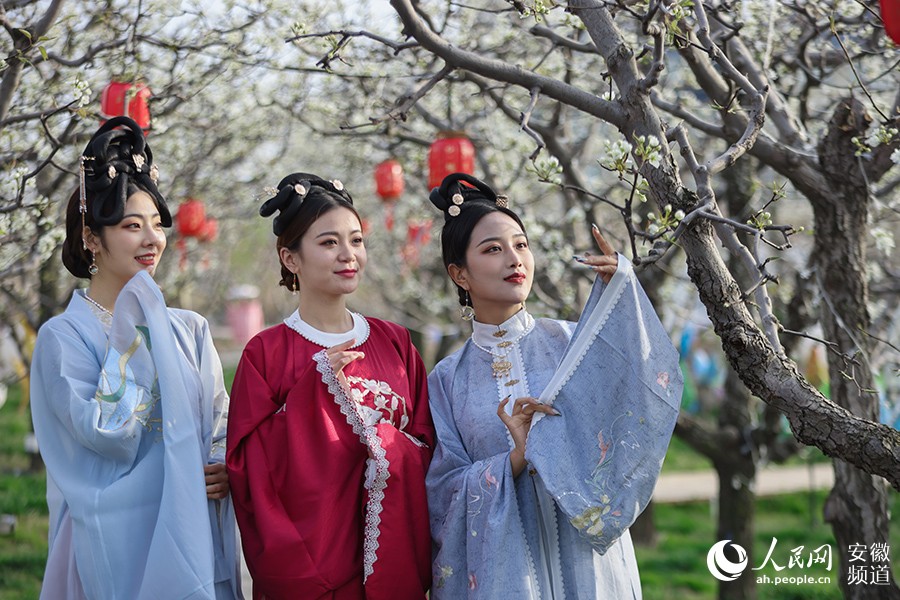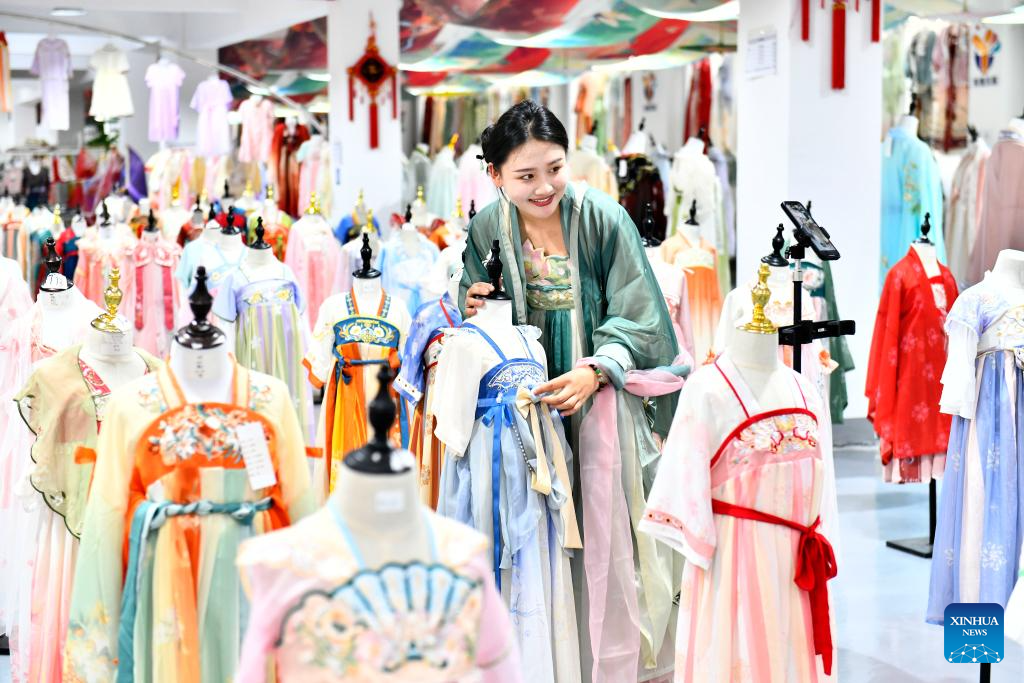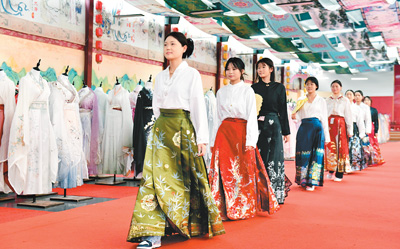
Fans of Hanfu dress up and indulge themselves among the pear blossoms at a garden in Dangshan, east China's Anhui Province. (People's Daily Online/Wang Xiaofei)
In recent years, clothes with Chinese elements and traditional features have become a new highlight in the consumer market.
China saw a surge in the consumption of guochao, also known as "China-chic," a fashion trend featuring modern designs mixed with traditional cultural elements, in 2023. Last year, the market size of guochao consumption stood at 2.05 trillion yuan (about $287.34 billion), up 9.44 percent year on year.
The market for Hanfu, or traditional Chinese costumes, has been growing steadily. The Hanfu market size reached 14.47 billion yuan in 2023 and is expected to soar to 24.18 billion yuan by 2027.
Caoxian county: Riding the Hanfu wave
Caoxian county in east China's Shandong Province has gained fame as a production base of Hanfu. The county takes up one third of the sales volume of Hanfu nationwide.

A woman sells Hanfu via livestreaming in Ancailou Township of Caoxian County, east China's Shandong Province, July 6, 2023. (Xinhua/Guo Xulei)
The thriving Hanfu industry in Caoxian began at the turn of the century when villagers started producing costumes for photo studios and theatrical costumes during farming off-seasons. As e-commerce took off, locals began to sell costumes online, and the county has nurtured China's largest market of theatrical costumes.
By July 2024, Caoxian had established itself as the country's second-largest cluster of Taobao villages, a title granted to villages with total annual e-commerce transactions of over 10 million yuan. It is home to 21 Taobao towns and 181 Taobao villages.
The success story of Hu Chunqing, head of the Caoxian Hanfu Association and founder of a clothing company, exemplifies the transformation of Caoxian's clothing industry. After returning to his hometown in 2014, Hu and his wife rode the wave of e-commerce, initially focusing on children's jazz dance costumes. As the market evolved and the "China chic" trend gained momentum, they established a Hanfu studio in 2020. So far, they have created over 560 Hanfu designs and obtained 320 Hanfu-related original artwork patents. With annual sales reaching 30 million yuan, their company has helped over 1,000 people find jobs.
Caoxian is currently home to 2,524 Hanfu companies, 14,718 online Hanfu stores, and 206 brick-and-mortar Hanfu experience stores, while close to 100,000 people are involved in the Hanfu industry. The county has developed a complete Hanfu industrial chain.
Lunjiao subdistrict: Producing "soft gold"
The dyeing and printing techniques for making gambiered Guangdong gauze, or Xiangyunsha in Chinese, a valuable silk fabric, have been passed on for over 100 years in Shunde district, Foshan city, south China's Guangdong Province and other parts of the Pearl River Delta region. Lunjiao subdistrict in Shunde district is the core production area of Xiangyunsha.
Dubbed "soft gold," Xiangyunsha requires delicate processes to complete. Xiangyunsha has been riding high on the fashion craze of new Chinese-style outfits since its recognition as a national-level intangible cultural heritage in 2008.
Thanks to the implementation of a local standard for Xiangyunsha, standardized production processes have been ensured to meet the requirements for contemporary garments and improve the quality of the fabric.
"Currently, the market requires Xiangyunsha clothing that is sophisticated and appealing to young people. Therefore, we integrate traditional elements with modern designs. For instance, our Xiangyunsha dresses featuring the 12 Chinese zodiac signs are in high demand," said Lin Hui, founder of Liangzhuang, a Xiangyunsha brand.
With a wide variety of styles, today's Xiangyunsha clothes incorporate materials used for Song brocade dating back to the Song Dynasty (960-1127) and other types of brocade in China, techniques for various types of Chinese embroidery, and contemporary design features. This fusion has ensured that custom-made Xiangyunsha clothes meet the aesthetics of modern life while maintaining traditional features.
At present, Lin's company has over 100 Xiangyunsha artisans, with its annual production value approaching 30 million yuan, marking a fourfold increase compared with that in its initial stage.
Supported by the China National Arts Fund, the company promoted Xiangyunsha across seven countries. It supplied specially designed Xiangyunsha products for the 31st FISU Summer World University Games in Chengdu, southwest China's Sichuan Province. Its Xiangyunsha clothes at the Silk Road International Fashion Week garnered widespread acclaim from both domestic and international counterparts, marking another milestone in bringing Xiangyunsha products to the global stage.
Practitioners in the Xiangyunsha industry should continue to inherit techniques and make innovations while cultivating young talents to lay a sound foundation for the sustained and healthy development of the sector, said Zhou Xiaogang, head of the Lunjiao Xiangyunsha association.
Hankou North Marketplace: Combining Hanfu with livestreaming
Ms. Chen, head of a livestreaming supply chain base in the Hankou North Marketplace in Wuhan, central China's Hubei Province, has spent over 30 years in the clothing industry, having operated stores and built her own clothing factory. Her original brand has been well-received by young and middle-aged consumers, with direct stores covering more than 50 large and medium-sized shopping malls across Hubei Province and over 500 regional agents nationwide.

Livestreamers wearing Hanfu walk the runway at a Hanfu base in Daji town, Caoxian county, east China's Shandong Province, Sept. 27, 2024. (Xinhua/Guo Xulei)
When traditional online platforms emerged, Chen was among the first in her industry to open multiple online accounts to expand sales channels. During 2020, she adapted to the trends, quickly setting up a live streaming account and leveraging her years of industry resources to transition into a clothing supply chain.
In Chen's view, the early advantages of traditional e-commerce channels are diminishing, and effectively utilizing new supply chain models to restructure digital strategies is the trend. After settling in the marketplace back in 2019, she capitalized on the market's strong influence and comprehensive live streaming services to create her supply chain store, providing Han style clothing products for various live streaming platforms. This has made her a key player in the revival of Han style apparel, successfully transitioning from a "traditional clothing trade service provider" to a "digital clothing industry supply chain platform."
In recent years, Han style apparel has been continuously innovated, creatively integrating elements from Han embroidery and Chu culture, and gaining popularity among young consumers.
In 2023, one of the most influential Han style clothing discount suppliers, Huipin Brand Clothing Supply Chain, established itself in Hankou North Marketplace, creating a 2,000-square-meter live streaming supply chain showroom to accelerate its integration into the e-commerce ecosystem.
Huipin Brand Clothing Supply Chain has its own manufacturing factory and design team. Over the past decade, it has continuously enhanced original design and cultural expression, incorporating Eastern aesthetics and national trend culture, enriching the fashion experience of Han style clothing. It collaborates with numerous apparel brands, serving over 3,000 downstream buyers across offline shopping malls and commercial streets nationwide.
The Hankou North Marketplace clothing live streaming supply chain base spans 300,000 square meters, gathering nearly 200 clothing supply chain companies and over 200 resident live streamers, including more than ten teams of influencers with follower counts in the millions. It is backed by the largest single-unit clothing wholesale market in central China, creating a textile and clothing supply chain platform that weaves a complete industrial chain across the nation.
With bustling, well-equipped live streaming rooms and established supply chain enterprises and merchants, these not only demonstrate the digital transformation of traditional clothing businesses but also represent the exploration of new development directions in the clothing industry.





